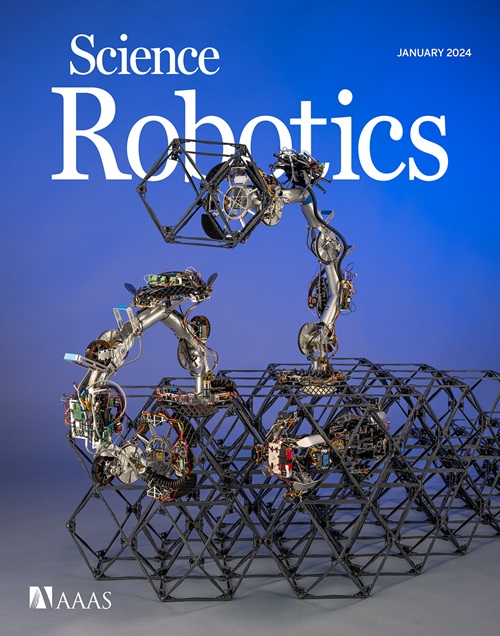解锁四轴飞行器的特技飞行潜力:自主自由式飞行的产生和执行
IF 27.5
1区 计算机科学
Q1 ROBOTICS
引用次数: 0
摘要
四轴无人机在熟练飞行员的手动控制下能够执行复杂的特技动作,但在开放空间自主飞行时仅限于简单的特技动作。因此,本研究引入了一个综合系统,使无人机能够在具有密集障碍物分布的复杂环境中生成并执行复杂的特技飞行动作。提出了一种通用的表示,简洁地将飞行捕捉为一系列离散的特技意图。这些意图包括拓扑结构和姿态变化,它们可以以各种方式组合在一起来描述复杂的飞行机动。引入了一种时空关节优化轨迹规划器,生成尽可能光滑且无碰撞的动态可行轨迹。此外,我们研究了特技飞行中独特的偏航灵敏度问题,并确定了微分平面奇异性对偏航旋转的固有影响,同时避免了相关的动力学问题。一系列的烧蚀研究证实了这些时空关节优化和偏航补偿策略的必要性。另外的仿真和物理实验验证了我们提出的系统的稳定性和可行性,以改善无人驾驶的空中飞行。该系统使无人机能够自主实现通常只有专业飞行员才能实现的飞行性能,为无人驾驶飞行器的特技飞行进化释放了无限的潜力。本文章由计算机程序翻译,如有差异,请以英文原文为准。
Unlocking aerobatic potential of quadcopters: Autonomous freestyle flight generation and execution
Quadcopter drones are capable of executing complex aerobatic maneuvers when controlled manually by skilled pilots but are limited to simple aerobatic actions when flying autonomously in open spaces. As such, this study introduces a comprehensive system that enables drones to generate and execute sophisticated aerobatic maneuvers in complex environments with dense obstacle distributions. A universal representation is proposed, succinctly capturing flight as a series of discrete aerobatic intentions. These intentions consist of topology and attitude changes, which can be combined in various ways to describe intricate flight maneuvers. A spatial-temporal joint optimization trajectory planner is also introduced to generate dynamically feasible trajectories that are as smooth as possible and devoid of collisions. In addition, we investigate unique yaw sensitivity issues in aerobatic flight and identify the inherent influence of differential flatness singularities on yaw rotations while avoiding associated dynamics issues. A series of ablation studies confirmed the necessity of these spatial-temporal joint optimization and yaw compensation strategies. Additional simulations and physical experiments validated the stability and feasibility of our proposed system for improving uncrewed aerial flight. The proposed system enables drones to autonomously achieve flight performance usually reserved for professional pilots, unlocking boundless potential for aerobatic flight evolution in uncrewed aerial vehicles.
求助全文
通过发布文献求助,成功后即可免费获取论文全文。
去求助
来源期刊

Science Robotics
Mathematics-Control and Optimization
CiteScore
30.60
自引率
2.80%
发文量
83
期刊介绍:
Science Robotics publishes original, peer-reviewed, science- or engineering-based research articles that advance the field of robotics. The journal also features editor-commissioned Reviews. An international team of academic editors holds Science Robotics articles to the same high-quality standard that is the hallmark of the Science family of journals.
Sub-topics include: actuators, advanced materials, artificial Intelligence, autonomous vehicles, bio-inspired design, exoskeletons, fabrication, field robotics, human-robot interaction, humanoids, industrial robotics, kinematics, machine learning, material science, medical technology, motion planning and control, micro- and nano-robotics, multi-robot control, sensors, service robotics, social and ethical issues, soft robotics, and space, planetary and undersea exploration.
 求助内容:
求助内容: 应助结果提醒方式:
应助结果提醒方式:


